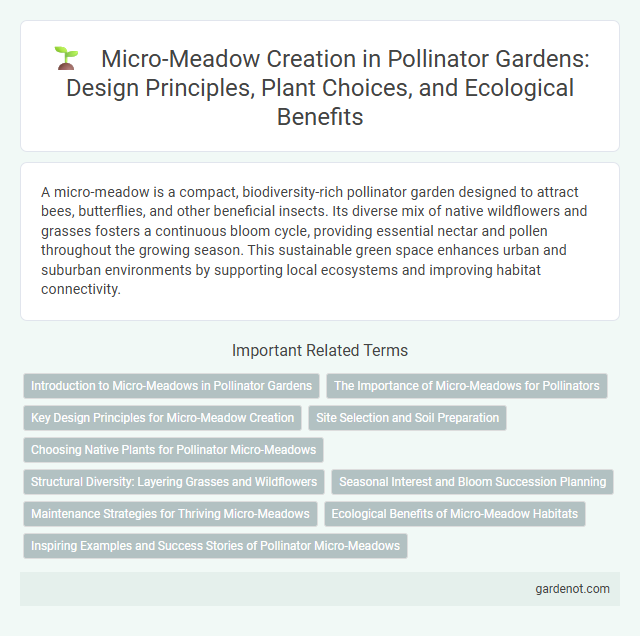A micro-meadow is a compact, biodiversity-rich pollinator garden designed to attract bees, butterflies, and other beneficial insects. Its diverse mix of native wildflowers and grasses fosters a continuous bloom cycle, providing essential nectar and pollen throughout the growing season. This sustainable green space enhances urban and suburban environments by supporting local ecosystems and improving habitat connectivity.
Introduction to Micro-Meadows in Pollinator Gardens
Micro-meadows are small, low-maintenance green spaces designed to support pollinators by providing diverse native wildflowers and grasses. These micro-meadows enhance biodiversity, offering essential habitats for bees, butterflies, and other beneficial insects in urban and residential areas. Incorporating native plant species ensures year-round forage, contributing to the health and sustainability of pollinator populations.
The Importance of Micro-Meadows for Pollinators
Micro-meadows provide vital habitats rich in native wildflowers, offering essential nectar and pollen resources for a diverse range of pollinators such as bees, butterflies, and hoverflies. These small-scale meadow ecosystems enhance biodiversity and support pollinator population health by supplying continuous blooming cycles throughout the growing season. Implementing micro-meadows in urban and suburban gardens contributes significantly to pollinator conservation by mitigating habitat fragmentation and increasing food availability.
Key Design Principles for Micro-Meadow Creation
Key design principles for micro-meadow creation include selecting native, pollinator-friendly plant species that support local biodiversity and ensure seasonal bloom succession for continuous nectar and pollen availability. Soil preparation must promote healthy root development while maintaining proper drainage and minimizing compaction to foster resilient plant communities. Strategic layering of plant heights and densities enhances habitat complexity, providing shelter and foraging opportunities for diverse pollinator species like bees, butterflies, and hoverflies.
Site Selection and Soil Preparation
Selecting a well-drained site with full to partial sunlight is crucial for establishing a thriving micro-meadow pollinator garden. Soil should be tested and amended with organic matter to improve fertility and structure, ensuring an ideal environment for native pollinator-friendly plants. Preparing the soil by removing weeds and loosening the topsoil enhances root penetration and promotes healthy plant growth.
Choosing Native Plants for Pollinator Micro-Meadows
Selecting native plants for pollinator micro-meadows enhances local biodiversity by providing essential nectar and pollen sources tailored to indigenous pollinators such as bees, butterflies, and hummingbirds. Native species like Echinacea purpurea, Asclepias tuberosa, and Solidago canadensis thrive in local soil and climate conditions, promoting sustainable growth and reducing maintenance requirements. Incorporating a variety of flowering plants with staggered bloom periods ensures continuous nourishment throughout the pollination season, supporting ecosystem health and resilience.
Structural Diversity: Layering Grasses and Wildflowers
Micro-meadows enhance pollinator gardens through structural diversity by layering native grasses and wildflowers, creating varied habitats that support different pollinator species. This vertical stratification offers diverse foraging and nesting opportunities, promoting biodiversity and ecosystem resilience. Incorporating a mix of grasses with differing heights alongside colorful wildflowers maximizes habitat complexity and resource availability for pollinators.
Seasonal Interest and Bloom Succession Planning
Micro-meadows enhance pollinator gardens by providing continuous floral resources through strategic bloom succession planning, ensuring diverse seasonal interest from early spring to late fall. Selecting native wildflowers and grasses with staggered flowering periods maximizes habitat availability for bees, butterflies, and other pollinators throughout the growing season. Effective micro-meadow design supports biodiversity and promotes ecosystem resilience by maintaining consistent nectar and pollen sources.
Maintenance Strategies for Thriving Micro-Meadows
Effective maintenance strategies for thriving micro-meadows include periodic mowing to prevent woody plant encroachment and promote wildflower growth. Targeted weeding eliminates invasive species that compete with native pollinators' preferred plants. Incorporating seasonal watering and soil health monitoring optimizes conditions for diverse pollinator populations and sustainable floral diversity.
Ecological Benefits of Micro-Meadow Habitats
Micro-meadow habitats enhance biodiversity by providing essential forage and nesting sites for native pollinators such as bees, butterflies, and hoverflies. These small-scale ecosystems support soil health through increased organic matter and microbial activity, promoting natural pest control and nutrient cycling. Integrating micro-meadows within pollinator gardens creates resilient green spaces that contribute to urban ecological balance and mitigate habitat fragmentation.
Inspiring Examples and Success Stories of Pollinator Micro-Meadows
Pollinator micro-meadows have transformed urban and suburban spaces into vibrant habitats supporting bees, butterflies, and other essential pollinators. Inspiring examples include the Portland Pollinator Pathway, which connects fragmented green spaces to boost biodiversity and pollinator movement across the city. Successful success stories from communities planting native wildflower micro-meadows demonstrate significant increases in local pollinator populations and enhanced ecosystem services.
Micro-meadow Infographic

 gardenot.com
gardenot.com